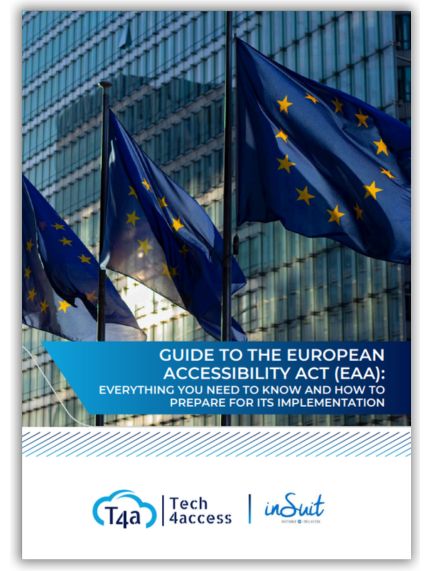

Private companies in the European Union are subject to a series of regulations that seek to ensure that their websites and mobile applications are accessible to all people, including those with disabilities.
Let’s not forget that web accessibility has become a fundamental aspect of ensuring equality and equal opportunities in access to information and online services, a basic right for all people.
To this end, it is important to be able to comply with the various regulations that require digital accessibility, which is why it is crucial to examine every detail of these regulations and understand how they affect private companies.
Below, we will explore these regulations in detail and their impact on the private sector. This analysis will allow us to better understand how to create a more inclusive and accessible digital environment for all users.
European regulatory framework for digital accessibility for private companies
European Directive 2019/882: The cornerstone of digital accessibility in Europe
European Directive 2019/882, known as the European Accessibility Act, marks a turning point in digital accessibility for private companies in the European Union. This directive establishes the accessibility requirements that websites and mobile applications of companies offering products and services to the public must meet.
Key point of Directive 2019/882:
According to this directive, companies must adhere to the UNE-EN 301549 standard, which incorporates the Level A and AA accessibility criteria of the Web Content Accessibility Guidelines (WCAG 2.1).
Based on these standards, digital content must be perceivable, operable, understandable, and robust. For this reason, companies must apply the required adjustments, such as those mentioned below:
- Alternative text for visual elements.
- Captions and transcripts for multimedia content.
- Keyboard-accessible navigation.
- Adequate contrast and scalable fonts.
- Compatibility with assistive technologies.
This directive also requires platforms to be compatible with technical aids for navigation, such as screen readers, ensuring an accessible experience for all users.
The regulation is essential for private companies in the EU seeking to work with public entities or expand their market.
Implementation deadlines vary depending on the type of company and service, with a deadline of June 28, 2025, for new products and services, and June 28, 2030, for those already on the market.
Web Accessibility Directive 2016/2102: Strengthening accessibility in the public sector
The Web Accessibility Directive 2016/2102 transposes accessibility requirements mainly for the EU public sector, extending accessibility requirements for websites and mobile applications of public bodies.
Key points of Directive 2016/2102:
- It establishes minimum accessibility requirements for websites and mobile applications of public sector bodies.
- Requires public bodies to provide clear accessibility statements about their products and services.
- Requires compatibility with the UNE-EN 301549 standard as the harmonized technical standard.
This directive complements the European Accessibility Act, focusing specifically on the public sector, while the EAA addresses the private sector.
Specific regulatory framework: UNE-EN 301549 standard
UNE-EN 301549 standard: A unified standard for Europe
The UNE-EN 301549 standard is the harmonized European standard that specifies accessibility requirements for information and communication technology (ICT) products and services.
Features of the UNE-EN 301549 standard:
Compliance with WCAG 2.1 level AA guidelines.
- Applicable to both web and non-web content (native applications, software, hardware).
- Additional measures such as compatibility with assistive technologies, keyboard navigation, and adequate contrast.
- Structure based on accessibility principles: perceivable, operable, understandable, and robust.
This standard positions Europe as a pioneer in defending the digital rights of people with disabilities, establishing a harmonized standard across the EU.
European regulation: European Accessibility Act (EAA)
European Union Directive 2019/882: A pan-European approach
The European Accessibility Act (EAA), which will be fully effective on June 28, 2025, seeks to harmonize accessibility requirements across the European Union.
Key points of the EAA:
- It affects sectors such as e-commerce, telecommunications, and financial services.
- It is based on the technical standard UNE-EN 301549.
- It requires compatibility with assistive technologies and sensory alternatives for multimedia content.
- It seeks to create a single digital market that is accessible throughout the EU.
Comply with the EAA and avoid risks for your company
Time is running out: June 2025 will be the turning point for digital accessibility in the EU. Is your company ready? Download our guide and learn the essential steps to comply with the regulations without complications.
inSuit: a solution for regulatory compliance
To help companies comply with these regulations, inSuit offers the Comprehensive Digital Accessibility Service (SIA®), which provides:
- Continuous assessment of website and application accessibility.
- Implementation of improvements to meet the required standards.
- AA level accessibility certification.
- Constant monitoring to maintain compliance.
Digital accessibility is no longer an option, but a legal and ethical obligation for private companies in the European Union. Complying with these regulations not only avoids penalties, but also expands the reach of services to a more diverse audience, improving the user experience and promoting digital inclusion.
Companies that proactively adopt these accessibility measures will not only comply with the law, but will also position themselves as leaders in corporate social responsibility, gaining the trust and loyalty of a broader spectrum of consumers.If your company needs to comply with accessibility regulations and you want to take advantage of all the benefits this offers, remember that we are here to provide you with a practical and customized solution, designed to fit your goals and needs.
